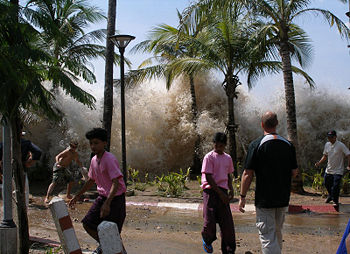Tsunami: Difference between revisions
Jump to navigation
Jump to search


imported>Thomas Wright Sulcer (created) |
imported>Chunbum Park mNo edit summary |
||
| (One intermediate revision by one other user not shown) | |||
| Line 1: | Line 1: | ||
{{subpages}} | {{subpages}} | ||
[[Image:2004-tsunami.jpg|thumb|right|350px|alt=Huge spray between palm trees as people appear to be running away.|In 2004 a huge tsunami struck various coastal regions of the [[Indian Ocean]], including this part of [[Thailand]].]] | [[Image:2004-tsunami.jpg|thumb|right|350px|alt=Huge spray between palm trees as people appear to be running away.|In 2004 a huge tsunami struck various coastal regions of the [[Indian Ocean]], including this part of [[Thailand]].]] | ||
'''Tsunami''' is a giant | '''Tsunami''' is a giant wave or wall of water, sometimes several stories tall, that causes tremendous destruction when it rolls in on a beach or low-lying areas or small islands. It is caused by undersea [[earthquakes]], particularly when a large slab or earth moves upwards according to the logic of [[plate tectonics]]<ref>[http://news.bbc.co.uk/1/hi/world/4136289.stm ''The tsunami disaster explained'', BBC News 30 December 2004]</ref>. They are rare, but when they happen, can be very deadly. A tsunami in 2004 killed over a hundred thousand people in diverse locations in countries around the [[Indian Ocean]] | ||
<ref>[http://news.bbc.co.uk/1/hi/in_depth/world/2004/asia_quake_disaster/default.stm ''Tsunami Disaster'', BBC News Special Report, 10 September 2008]</ref>. A Tsunami and earthquake that struck Japan in 2011 resulted in a death toll of 9,079, with 12,645 missing, and a major setback to the Japanese economy<ref>[http://www.bbc.co.uk/news/business-12828181 ''Japan says quake rebuilding to cost as much as 25tn yen'', BBC News 26 March 2011]</ref>. | |||
==References== | ==References== | ||
{{reflist}} | {{reflist}} | ||
Latest revision as of 11:45, 11 October 2011

In 2004 a huge tsunami struck various coastal regions of the Indian Ocean, including this part of Thailand.
Tsunami is a giant wave or wall of water, sometimes several stories tall, that causes tremendous destruction when it rolls in on a beach or low-lying areas or small islands. It is caused by undersea earthquakes, particularly when a large slab or earth moves upwards according to the logic of plate tectonics[1]. They are rare, but when they happen, can be very deadly. A tsunami in 2004 killed over a hundred thousand people in diverse locations in countries around the Indian Ocean [2]. A Tsunami and earthquake that struck Japan in 2011 resulted in a death toll of 9,079, with 12,645 missing, and a major setback to the Japanese economy[3].